

Over the last few weeks many places in Scotland have been celebrating the civic week. The civic week is a tradition in the Scottish borders in which they celebrate the tradition of common ridings. Where in the early 20th century, landowners in the Scottish borders would ward off thieves such as local families or the English by marking their territory on horseback. This tradition has lived on and is now used to celebrate many parts of the communities.
In Kelso, the week was celebrated from the 10 th to the 22 nd . These dates were chosen because of the rich history of the festival. The festival’s origins date back to 1934 in which the residents of Kelso held a fancy-dress parade for the lifeboats. The next year the same thing was done to support the local hospital. This would later be merged with the shopping week to create the civic festival that is celebrated today.
The town of Kelso has a rich local history, such as the abbeys destruction by the English army in 1545. Although the abbey was destroyed the town was repairable and survived the fighting. Due to the industrial revolution in the 18 th century, the quiet village boomed in production of products such as shoes as the leatherworking industry expanded. This led to the town growing in wealth and thus expanding from a population of 4,196 in 1801 to a population of 6,900 in 2021.
Sir Walter Scott (The Historian and playwright) was educated in the town in which he wrote about its beauty. Sir Walter Scott described the town as, “Few villages can surpass that near to which I am now writing; and as to your rivers, it is part of my creed that the Tweed and Teviot yield to none in the world… For antiquities, it is true we have got no temples… but if substantial old castles and ruined abbeys will serve in their stead, they are to be found in abundance.”
The town was also the birthplace of Georgiana Soloman. The school principal was also the suffragette who broke the windows in the house of lords. She spent a lot of time trying to help south Africa and she fought for equality in race in South Africa until her death in 1933. Georgiana was an advocate for women's education and moved to south Africa to assist in its suffrage movement. She was known for her vocal opposition of the ‘Native lands act of 1913, which made racism in south Africa official in law and prevented the black population from owning property in South Africa.
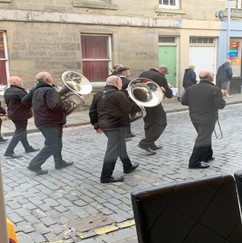
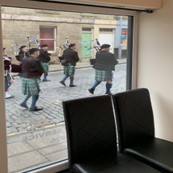
Certain elements of the tradition have been kept such as this band which had a bagpipe section. This was taken at the civic week in Kelso
With the celebrations in the town of Kelso featuring a wide range of activities from tennis challenges, a fancy-dress parade (The more historical part of the events) to horse riding journeys (Such as the ride from Kelso to Hume) and a grand ball. The event has created a tradition of electing a Kelso Laddie. The role of the laddie is to carry the ceremonial flag around Kelso with support from his left-hand and right-hand men. This year the laddie was Andrew Thomson who was supported by his left-hand man, Mark Henderson, and his right-hand man, Callum Davidson.
The event brough along many local musicians such as the Blackthorne Ceilidh Band, the band was set to play in the Kelso town square but had to move to the Cross-key's hotel due to the severe weather. The band played on the Saturday and the event was enjoyed by those who attended. They were supposed to play as the equestrians arrived back from Yetholm, a village in the borders in which it is traditionally connected to the civic celebrations.
In croft park the funfair came to Kelso for the week. In celebration of the civic week there was competitions for free tickets. The funfair brough a variety of rides from the ghost train to the teacups. The funfair ran at the same time and even had days in which their prices were cut as to help celebrate the festival. The company have been providing activities for the civic week for decades according to the organisers.
These events have been funded mostly by the community through charitable donations however some of the money has been supplied by government grants. Businesses such as the W.J. Jewlers helped fund many of the events, and even made some limited-edition items for the even itself such as a jewellery line. They jewellers sponsored both the juniors and seniors five aside football match.
During the fancy dress procession many people came in floats or vehicles-6 such as tractors and motorbikes. These all focused on different themes such as the Kelso united thistle, who hired a float for the local football team. They all wore the black and white stripped kit as they went past the gathered crowds. One member of the club had an inflatable shark which was dropped and kindly returned by a member of the public.
One highlight was Kelso’s German community who stood up to the challenge and got dressed up for the occasion however a motorbike also was present.
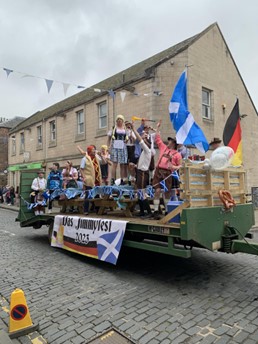
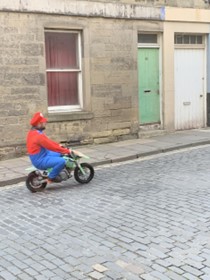
The festival allowed a procession of the town's residents to parade without floats or motors. This ended with people with political costumes taking the opportunity to have a jab at the MPs such as the, disgraced prime minister Boris Johnson. Another person came dressed as Prince Harry.
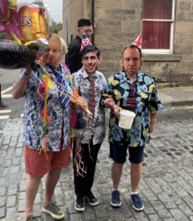
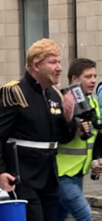
The events were projected to bring in 10,000 people to the small town of Kelso. The town only has about 6000 residents and so the event brough in considerable money fort the towns tourism trade. The event provides a great show to those who live in the area and beyond, providing money for Kelso’s tourism economy. The events all formed to be successful and created a great civic week.